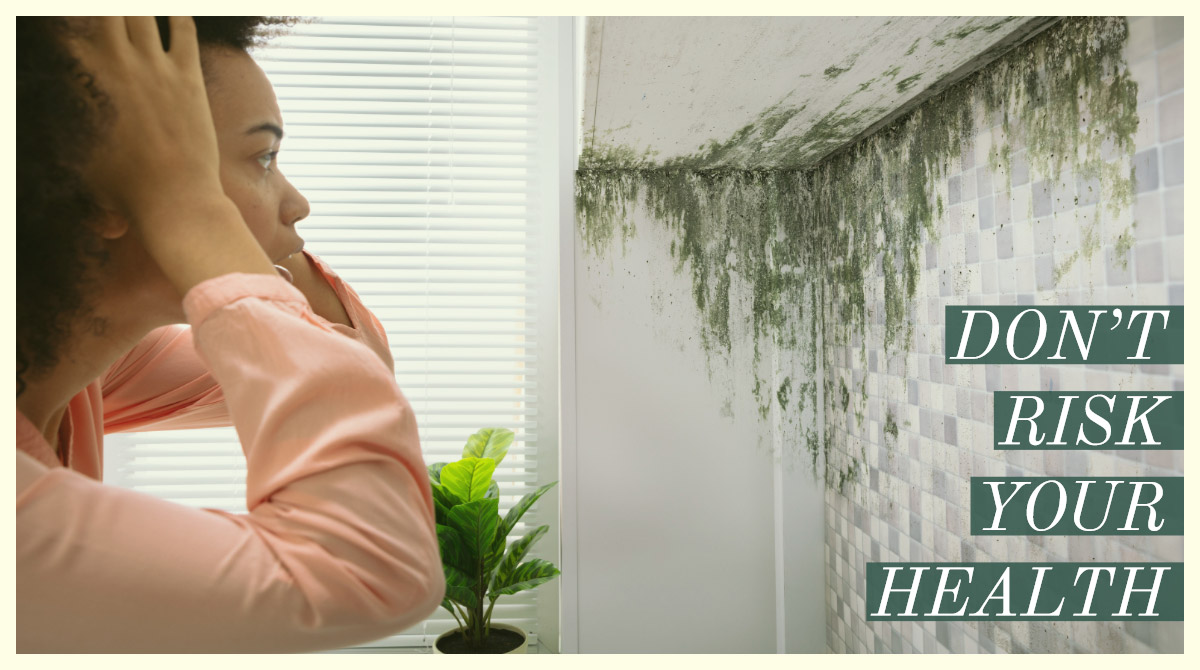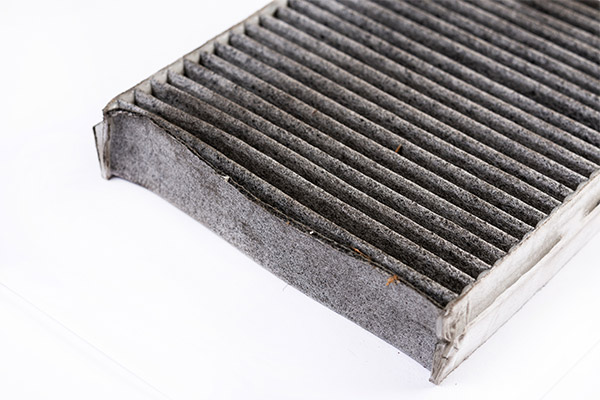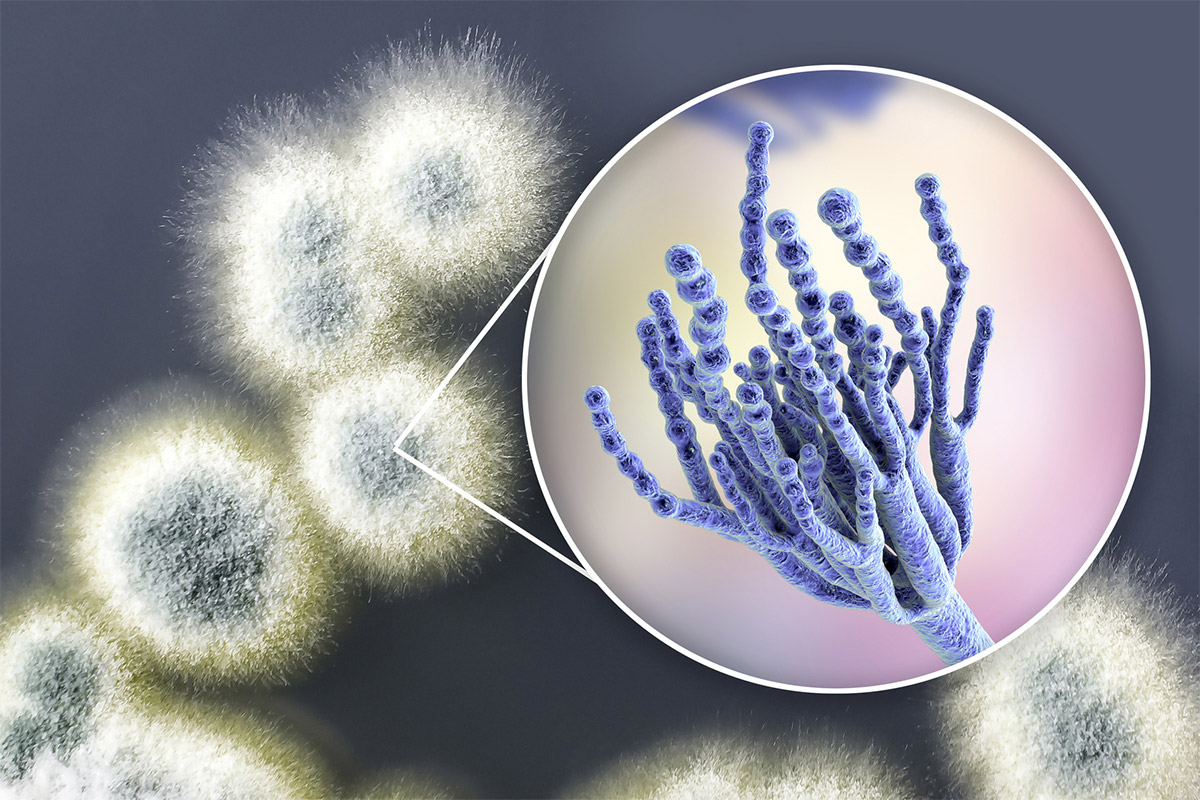Dampness, Mould and Health

- Sep 5, 2019 modified: Dec, 27 2024
Dampness, Mould and Health
Is your home killing you or just making you sick?
Dampness and Your Health
Healthy indoor air is recognized as a basic right. People spend a large part of their time each day indoors: in homes, offices, schools, health care facilities, or other private or public buildings. The quality of the air they breathe in those buildings is an important determinant of their health and well-being. The inadequate control of indoor air quality therefore creates a considerable health burden.
When sufficient moisture is available, hundreds of species of bacteria and fungi -; particularly mould -; pollute indoor air. The most important effects of exposure to these pollutants are the increased prevalence of respiratory symptoms, allergies and asthma, as well as disturbance of the immune system. Preventing (or minimizing) persistent dampness and microbial growth on interior surfaces and building structures is the most important means of avoiding harmful effects on health.
Moulds have been on the Earth for millions of years. Mould is everywhere -; in the air and on many surfaces.
Indoor environments contain a complex mixture of live (viable) and dead (nonviable) micro-organisms and fragments, toxins, allergens, volatile microbial organic compounds and other chemicals. The indoor concentrations of some of these organisms and agents are known or suspected to be elevated in damp indoor environments.
Both dust mites and fungi favour damp environments and are suspected of playing a major role in producing allergens known to be associated with allergies and asthma. Many fungi also produce toxins and irritants with suspected effects on respiratory health.

Sufficient epidemiological evidence is available from studies conducted in different countries and under different climatic conditions to show that the occupants of damp or mouldy buildings, both houses and public buildings, are at increased risk of respiratory symptoms, respiratory infections and exacerbation of asthma…results show that remediation of dampness problems can reduce adverse health outcomes.
(adapted from https://www.who.int/airpollution/guidelines/dampness-mould/en/)
Dust mites
House dust mites are arachnids and while many different species have been identified only a few are relevant in relation to damp indoor environments. The natural food source of house-dust mites includes skin scales and therefore in most houses nutrition is abundantly available, particularly in mattresses, carpets or rugs. Damp houses, therefore, significantly increase exposure to dust-mite allergens, at least in populations living in mild and temperate climates. Laboratory studies have shown that most dust mites require a relative humidity in excess of 45-50% for survival and development, but they feed and multiply more rapidly at higher relative humidity (Arlian, 1992).
Bacteria
As described for fungi, water is a critical requirement for bacterial growth. In fact, bacteria require higher water activities than most fungi. The temperature and nutrient demands are generally met in most indoor environments. Surprisingly, few studies have been conducted on bacterial growth in damp houses. Those that have, suggest that bacteria grow in the same areas as fungi. Their presence in indoor air may therefore indicate that a building has a moisture problem (Samson et al., 1994).
Fungi
Fungi are "ubiquitous eukaryotic organisms", comprising an abundance of species.
They may be transported into buildings on the surface of new materials or on clothing. They may also penetrate buildings through active or passive ventilation.
Fungi are therefore found in the dust and surfaces of every house, including those with no problems with damp. Once fungi are indoors, fungal growth can occur only in the presence of moisture, and many fungi grow readily on any surface that becomes wet or moistened; that is, virtually all fungi readily germinate and grow on substrates in equilibrium with a relative humidity below saturation (i.e. below 100%).
Protozoa
It has been proposed that protozoa play a role in the complex mixture of exposures that contribute to adverse health effects associated with damp indoor environments (Yli-Pirila et al., 2004). In this study, amoeba were detected in 22% of 124 material samples from moisture-damaged buildings. Most of the samples of materials that were badly damaged by moisture were found to contain ciliates and flagellates. No field studies have been conducted to assess the airborne concentrations of protozoa or fragments so it is not clear whether protozoa in damp buildings contribute to ill health.
(summarised from https://www.who.int/airpollution/guidelines/dampness-mould/en/)

Mould in the Home
In 2004, the Institute of Medicine (IOM) USA found there was sufficient evidence to link indoor exposure to mould with upper respiratory tract symptoms, cough and wheeze in otherwise healthy people; with asthma symptoms in people with asthma; and with hypersensitivity pneumonitis in individuals susceptible to that immune-mediated condition. The IOM also found limited or suggestive evidence linking indoor mould exposure and respiratory illness in otherwise healthy children.
Mould is found both indoors and outdoors and can enter your home through open doorways, windows, vents, heating and air conditioning systems. Mould can be carried indoors from the air outside by attaching itself to clothing, shoes, bags and pets.
Mould will grow in areas around leaks in roofs, windows, pipes or where there has been flooding. Mould also grows well on paper products, cardboard, ceiling tiles and wood products. And mould can grow in dust, paints, wallpaper, insulation, drywall, carpet, fabric and upholstery.
(adapted from https://www.cdc.gov/mould/dampness_facts.htm)
Mould and Your Health
Symptoms that reveal the possible effects of mould and dust mites in your home include:
- Coughing
- Wheezing
- Dyspnoea (shortness of breath)
- Asthma Attacks
- Irritation (skin and eyes)
- Itching (skin and eyes)
Health outcomes may include Asthma; Infections (Bronchitis, Fungal); and Allergies (Alveolitis -; inflammatory lung disorder).
World Health Organisation (WHO) studies suggest that owing to Climate Change and its effects on weather (increases in the frequency, intensity and duration of storms, heavy rainfall and floods) and the subsequent rise in sea levels, there will be an increase in the proportion of buildings around the world suffering from dampness problems.
Buildings and homes in flood prone areas such as river valleys and coastal areas are most at risk.
Areas at Risk in Your Home
The following technical descriptions may alert you to the signs and areas in your home that are most at risk of mould and other microbial growths if they are not regularly cleaned or maintained :-
Air-conditioning systems: equipment for treating air to simultaneously control temperature, humidity, cleanliness and distribution to meet the requirements of a conditioned space.
Dampness and excess moisture: any visible, measurable or perceived outcome of excess moisture that causes problems in buildings, such as mould, leaks or material degradation, mould odour or directly measured excess moisture or microbial growth [especially around window frames; roof gutters and downpipes; and roof and wall cladding].
Moisture: (1) water vapour; (2) water in a medium, such as soil or building insulation, but not bulk water or flowing water.
Excess moisture: Any moisture state variable that is higher than a design criterion, usually represented as moisture content or relative humidity in building material or the air.
Moisture and water damage: any visible, measurable or perceived outcome caused by excess moisture indicating indoor climate problems or problems of durability in building assemblies. Moisture damage is a particular problem related to building assembly durability. Water damage is a moisture problem caused by various leaks of water.
Moisture transport: moisture can be transported in both the vapour and the liquid phase by diffusion, convection, capillary suction, wind pressure and gravity (water pressure). [This is particularly relevant in homes in flood prone or intense storm locations].
Mould: all species of microscopic fungi that grow in the form of multi-cellular filaments, called hyphae. In contrast, microscopic fungi that grow as single cells are called yeasts.
Ventilation: process of supplying or removing air by natural or mechanical means to or from any space; the air may or may not have been conditioned. [Poorly maintained ventilation systems may contribute to the proliferation of mould and other microbial growths].
Global Trends in Building Practices
Several widely acknowledged global trends contribute to the conditions associated with increased exposure to dampness and mould; for instance, energy conservation measures that are not properly implemented such as tightened building envelopes, ventilation deficits and improper insulation.
Migration to heavily urbanised centres, building type and density, urban degradation, housing availability and social inequity have also contributed to poor building practices and a likely increase in health issues related to mould and dampness.
Climate change with its increasing frequency of extreme weather conditions and the shifting of climate zones; an increase in the 'globalization' of construction concepts and techniques; and a decrease in the quality of building materials and components have led to the conditions that increase the risks of adverse health effects due to biological contaminants of indoor air.
Controlling Mould
Mould prevention tips for your home may include the following:
- Keep humidity levels as low as you can - no higher than 50% all day long. An air conditioner or dehumidifier will help you keep the level low. Bear in mind that humidity levels change over the course of a day with changes in the moisture in the air and the air temperature, so you will need to check the humidity levels more than once a day.
- Be sure your home has enough ventilation. Use exhaust fans which vent outside your home in the kitchen and bathroom. Make sure your clothes dryer vents outside your home.
- Fix any leaks in your home's roof, walls, or plumbing so mould does not have moisture to grow.
- Clean up and dry out your home thoroughly and quickly (within 24-;48 hours) after flooding.
- Add mould inhibitors to paints before painting.
- Clean bathrooms with mould-killing products.
- Remove or replace carpets and upholstery that have been soaked and cannot be dried promptly. Consider not using carpet in rooms or areas like bathrooms or basements that may have a lot of moisture.
Our Battle Against Mould
Areas such as the Gold Coast and Brisbane in SE Queensland and Byron Bay in Northern NSW are located in sub-tropical coastal, flood prone areas. Owing to climate change, these regions are becoming increasingly more tropical in their weather patterns, including increased cyclone activity and subsequently they are more prone to dampness in buildings and houses.
Mould needs just three things to grow: moisture, a nutrient, and a warm environment. This is why cleaning with bleach is just a temporary solution. Once the moisture and heat return, mould will start growing again.
Toxic spores begin to multiply very quickly, infecting everything in their surrounds. Approximately 15,000 spores are equivalent to the size of a pin head.
Mould will contaminate contents (furniture, clothes, food, paper etc). These items also act as food for spores and worse, they are extremely harmful to your health.
The Power of Ozone
Ozone is nature's own purifier. When a thunder storm rumbles and lighting strikes and when the surf crashes on the beach, you can smell the purity of ozone in the air.
Ozone Treatments harness the natural purification power of Ozone for mould and bacteria elimination. The correct remediation processes are set out in the Australian Mould Guidelines.
Ozone is the strongest commercial sterilant in the world, leaving no toxic residue, reverting back to Oxygen (O2) once treatment with Ozone has finished. Ozone is 3,000 times stronger the chlorine.
How ozone works......
O2 is turned into O3 in a generator and then pumped into the contaminated room. The third atom of the O3 gas splits off and attaches to the airborne offending organisms, oxidising and destroying them by breaking them completely down.
AMC Ozone generators produce zero nitrous oxide, leaving no toxic residue behind after the mould removal treatment is complete.
Ozone kills mould on contact, even the loose spores you cannot see in some places in the home.
Video: amcozone animation of O3 in action
AMC Ozone offer mould treatments and removal in Brisbane, Gold Coast and beyond.
Air Conditioner Contamination
One cause of indoor air contamination is due to bacterial and fungal contamination of air filters, heat transfer coils and duct-work within air conditioning systems that are poorly designed and maintained.
Air conditioning ducts should be regularly inspected to ensure there is no excessive dust build up on surfaces (airborne dust will deposit to these surfaces over time). Fungi and mould growths can occur in ducts where condensation occurs. If these can be seen, call an air conditioner specialist to fix the cause of the condensation and to clean or remediate the air conditioner. Ideally, this will prevent mould and fungi from continuing to grow.
If you find large amounts fungi or mould growing in the air conditioner ducts, first you need to fix the cause of moisture that's supporting the growths. Fungi and moulds won't grow without moisture/condensation. If you clean them without fixing the moisture problem, they'll re-occur. Do not try and remove large quantities yourself and/or clean them in bleach. Mould can be highly toxic and if found in large quantities should always be handled by a professional.

Cleaning ducts require specialised equipment to get along the lengthy ducts and most importantly to capture and contain the dust released so that it doesn't contaminate your home. Make sure you use a reputable professional cleaner and ask them questions about these things.
If you do nothing, your air conditioner will continue to release odorous gases and fungal spores, which can impact respiratory health, such as flu-like symptoms, asthma, respiratory tract infections, allergic reactions and toxic reactions.
JT Air Conditioning has over 20 years experience in quality air conditioning and electrical services around Brisbane, Gold Coast, Ipswich and out to Jimboomba and Beaudesert in SE Queensland.
Pool Care and Maintenance
A swimming pool needs maintenance to keep the water quality safe for swimming and to prevent pool equipment from breaking down.
Without regular sanitisation, all pools develop bacteria -; which can pose serious health risks. Water top-ups, leaves, grass, dust, and even people all cause bacteria to grow; these factors, along with the size of your pool, will determine the level of sanitisation you need.
Most pool owners use chlorine. There are other options to keep pool water clean and in balance -; such as using ozone gas, UV sterilisation, bromine or ionization -; but these methods make up a very small part of the Australian market. Health departments around Australia generally recommend all domestic pool owners have a chlorine residual in their pool.
Reliable Pool Care is a local family business established in 2001 to provide a reliable and consistent pool cleaning mobile service that comes to clean pools in Brisbane and the Gold Coast.
Black Algae in Your Pool can be caused by someone swimming with the same garments they wore at a river. It looks like tiny black dots or big clumps of mould. The algae attaches to porous surfaces typically in a pool.
Breaking the Mould
The prevalence of indoor dampness varies widely within and among countries,
continents and climate zones. However, WHO estimate that dampness affects 10-;50% of indoor environments in Australia, Europe, India, Japan and North America. In certain settings, such as river valleys and coastal areas, the conditions of dampness are substantially more severe than the national average.
While dampness leading to mould growing in your home may not be killing you, it most certainly will be contributing to health issues and sickness in family members, particularly children and the elderly.
It's time to take positive action to eliminate mould from our homes. There are exceptions of course; that is, the good moulds, bacteria, fungi and yeasts we use in the production of beer, wine, breads, yoghurt and certain delicious cheeses. And did we mention sautéed mushrooms?

Sources and References
WHO guidelines for indoor air quality: dampness and mould
Authors: WHO Regional Office for Europe. 2009
https://www.who.int/airpollution/guidelines/dampness-mould/en/
Centre for Disease Control and Prevention. Dpt of Health and Human Services, USA.
https://www.cdc.gov/mould/dampness_facts.htm
CHOICE: Independent and member funded Australian leading consumer advocacy group.
https://www.choice.com.au/outdoor/pools/cleaning-and-maintenance/articles/pool-maintenance-guide
Researched, Compiled, Composed and Written by Dr Steven Gration -; August 2019
Search News Articles...
Recent Articles

Unique Web Systems Matter in a World of Sameness
- Dec 26 2025
- /
- 38

Most AI Websites Fail to Rank
- Nov 18 2025
- /
- 267

Sitemap.xml Best Practices
- Oct 14 2025
- /
- 948

Fake Reviews on Google My Business
- Oct 07 2025
- /
- 483

Sending Emails from Code
- Sep 17 2025
- /
- 578

US Tariff Shifts Undermining eCommerce
- Sep 05 2025
- /
- 709

Small Business Success Formula
- Aug 23 2025
- /
- 541

Do Strong CTAs Help or Hurt Your Website?
- Jul 31 2025
- /
- 737

AI Crawlers vs Search Crawlers
- Jul 04 2025
- /
- 944

AI vs. Human Writing - How to detect Ai
- Jun 26 2025
- /
- 1327
View All News Articles
Categories
A Gold Coast SEO and Web Developer
